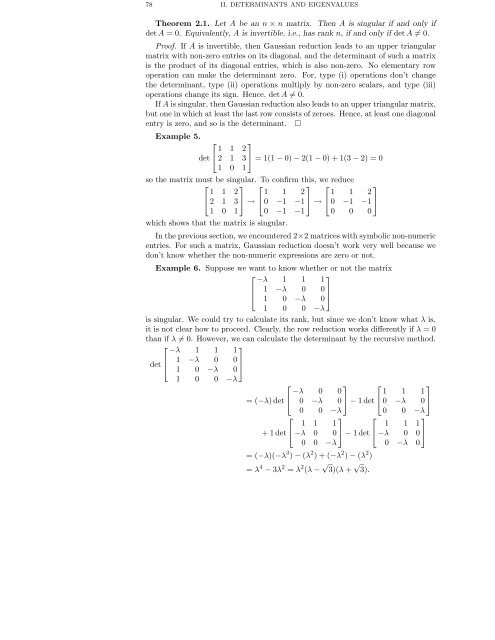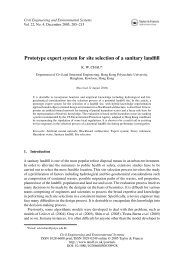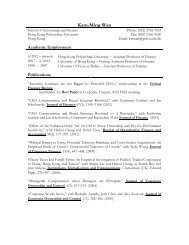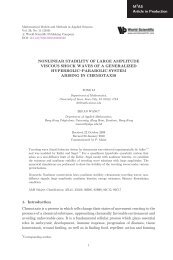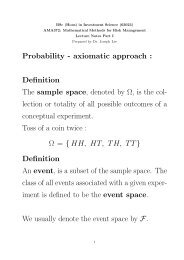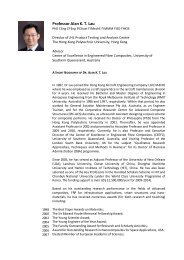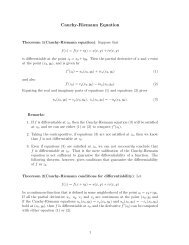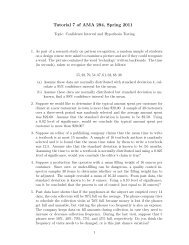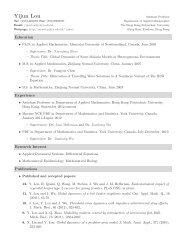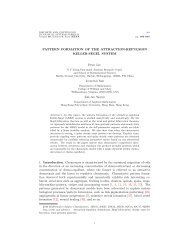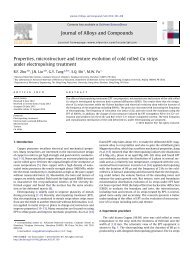DETERMINANTS AND EIGENVALUES 1. Introduction Gauss ...
DETERMINANTS AND EIGENVALUES 1. Introduction Gauss ...
DETERMINANTS AND EIGENVALUES 1. Introduction Gauss ...
You also want an ePaper? Increase the reach of your titles
YUMPU automatically turns print PDFs into web optimized ePapers that Google loves.
78 II. <strong>DETERMINANTS</strong> <strong>AND</strong> <strong>EIGENVALUES</strong>Theorem 2.<strong>1.</strong> Let A be an n × n matrix. Then A is singular if and only ifdet A =0. Equivalently, A is invertible, i.e., has rank n, if and only if det A ≠0.Proof. If A is invertible, then <strong>Gauss</strong>ian reduction leads to an upper triangularmatrix with non-zero entries on its diagonal, and the determinant of such a matrixis the product of its diagonal entries, which is also non-zero. No elementary rowoperation can make the determinant zero. For, type (i) operations don’t changethe determinant, type (ii) operations multiply by non-zero scalars, and type (iii)operations change its sign. Hence, det A ≠0.If A is singular, then <strong>Gauss</strong>ian reduction also leads to an upper triangular matrix,but one in which at least the last row consists of zeroes. Hence, at least one diagonalentry is zero, and so is the determinant. □Example 5.⎡det ⎣ 1 1 2⎤2 1 3⎦ = 1(1 − 0) − 2(1 − 0) + 1(3 − 2)=01 0 1so the matrix must be singular. To confirm this, we reduce⎡⎣ 1 1 2⎤ ⎡2 1 3⎦ → ⎣ 1 1 2⎤ ⎡0 −1 −1⎦ → ⎣ 1 1 2⎤0 −1 −1⎦1 0 1 0 −1 −1 0 0 0which shows that the matrix is singular.In the previous section, we encountered 2×2 matrices with symbolic non-numericentries. For such a matrix, <strong>Gauss</strong>ian reduction doesn’t work very well because wedon’t know whether the non-numeric expressions are zero or not.Example 6. Suppose we want to know whether or not the matrix⎡⎤−λ 1 1 1⎢ 1 −λ 0 0⎥⎣⎦1 0 −λ 01 0 0 −λis singular. We could try to calculate its rank, but since we don’t know what λ is,it is not clear how to proceed. Clearly, the row reduction works differently if λ =0than if λ ≠ 0. However, we can calculate the determinant by the recursive method.⎡⎤−λ 1 1 1⎢det ⎣1 −λ 0 0⎥⎦1 0 −λ 01 0 0 −λ⎡=(−λ) det ⎣ −λ 0 0⎤ ⎡0 −λ 0⎦−1 det ⎣ 1 1 1⎤0 −λ 0⎦0 0 −λ0 0 −λ⎡+ 1 det ⎣ 1 1 1⎤ ⎡−λ 0 0⎦−1 det ⎣ 1 1 1⎤−λ 0 0⎦0 0 −λ0 −λ 0=(−λ)(−λ 3 ) − (λ 2 )+(−λ 2 )−(λ 2 )=λ 4 −3λ 2 =λ 2 (λ− √ 3)(λ + √ 3).


